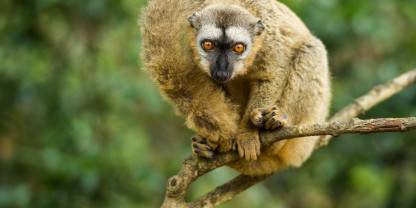Average Expert Rating
Rating Breakdown
5 star
0 / 3
0
4 star
3 / 3
3
3 star
0 / 3
0
2 star
0 / 3
0
1 star
0 / 3
0
Write a User Review
4 star
3 star
2 star
1 star
One-Stop Lemur Shop
If you only visit one national park in Madagascar, make it Andasibe-Mantadia. Situated a mere 145km east of the capital Antananarivo, this is the country’s most popular wildlife destination, and it also has the best selection of tourist amenities. Our highlight on both previous visits was a close-up encounter with the indri, a large tailless panda-like lemur whose eerie high-pitched call is ear-shattering at close range and can be heard from up to 2km away. Andasibe-Mantadia supports 11 other primate species, including the striking and easily seen diademed sifaka, as well as the diminutive Goodman’s mouse lemur, the latter a local endemic only discovered in 2005. Day walks along the main road through the forest can be wonderful for birding, offering first-time visitors a crash course in some of the island’s more widespread forest endemics, including the turaco-like blue and red-breasted coua, Madagascar paradise flycatcher, nuthatch vanga and Madagascar cuckoo-shrike. We also dropped
Read more
into the Parc des Orchidées to see some of the forest’s 100-plus orchid species, and after dusk took a guided night walk in search of nocturnal lemurs, chameleons and colourful tree-frogs. For dedicated birders, it is worth heading to the remote Mantadia sector, the best place to seek out the shy and localised, scaly, pitta-like rufous-headed and short-legged ground-rollers.An Opera of Indris
Imagine a wolf howling to the rhythm and cadence of a humpback whale, and you’ll have a good idea of what an indri sounds like. In my humble opinion, it is one of the most beautiful songs in all of nature.
You’ll hear these melancholy melodies from any of the numerous accommodation options in and around the quaint little village of Andasibe. But once you are deep inside those dense evergreen forests of the national park itself, the sound echoes and reverberates, lending yet more ambience to an ecosystem already dripping with atmosphere.
Expect to encounter numerous primates in this rainforest region; ranging from tiny mouse lemurs and diminutive nocturnal woolly lemurs to the relatively large diademed sifakas, and, of course, those pied Pavarottis of the forests – the indris.
Most of the animals of Andasibe-Mantadia are habituated (meaning they are not afraid of humans and will go about their daily activities as if you weren’t there watching
You’ll hear these melancholy melodies from any of the numerous accommodation options in and around the quaint little village of Andasibe. But once you are deep inside those dense evergreen forests of the national park itself, the sound echoes and reverberates, lending yet more ambience to an ecosystem already dripping with atmosphere.
Expect to encounter numerous primates in this rainforest region; ranging from tiny mouse lemurs and diminutive nocturnal woolly lemurs to the relatively large diademed sifakas, and, of course, those pied Pavarottis of the forests – the indris.
Most of the animals of Andasibe-Mantadia are habituated (meaning they are not afraid of humans and will go about their daily activities as if you weren’t there watching
Read more
them). Therefore, expect some wonderful forest walks, resplendent with wildlife sightings and an acoustical accompaniment like no other on Earth.The Wailing Indris of Andasibe
After arriving in Antananarivo, the busy capital city of Madagascar, the first stop on my safari was Andasibe-Mantadia National Park. More than anything, I wanted to see lemurs. With 12 species recorded, Andasibe was unlikely to disappoint. On arrival, I marveled at the bug-eyed common brown lemurs that leaped from tree to tree around our lodge and the next morning, we set off in search of the island’s largest and most iconic lemur, the indri. After a few hours hiking along the slippery slopes of the jungle, we struck gold: a small family of these black-and-white, teddy-bear-like creatures was feeding high in the canopy. The future of the indri, which has never fared well in captivity, is very unsure as they are restricted to Andasibe-Mantadia and a handful of nearby areas where habitat destruction due to mining and logging is an ongoing concern. I felt privileged to see these endangered animals, but it was their unique wailing vocalizations that have really stuck with me. When we left,

